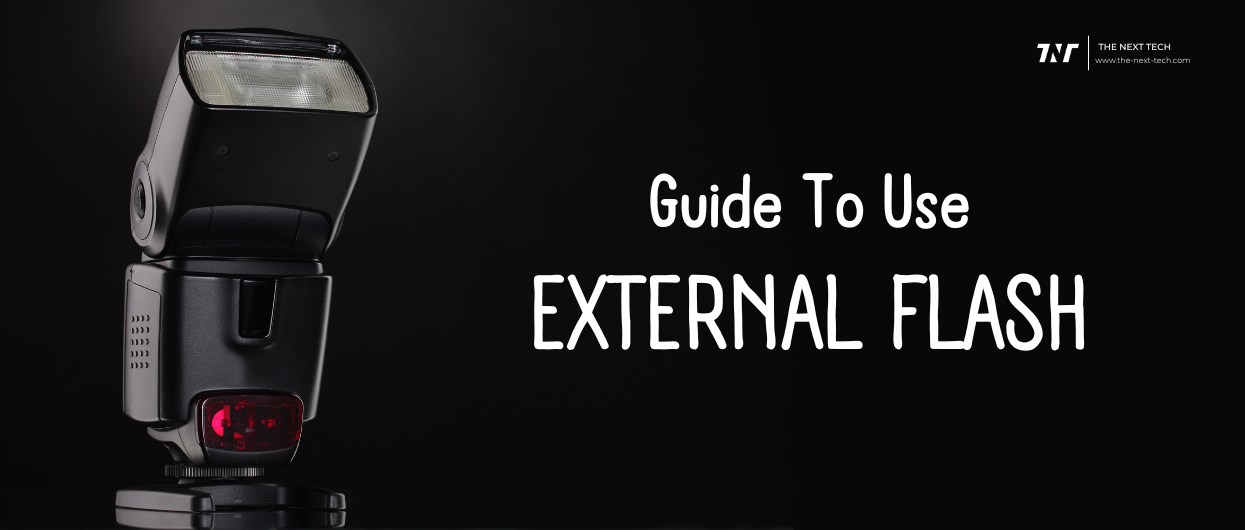
Flash systems on cameras add versatility in photography, allowing photographers to capture moments more clear and with better exposure.
Flash allows photographers to capture scenes even in dark or low light situations. But knowing when to use and how to use it is important to know at priority.
In this blog, you will learn how to use external flash on either DSLR or mirrorless cameras you have.
Guide To Use External Flash System
Indeed, using flash all the time is not a good sign because it may ruin your photography. So, when to use and when to avoid, can make a big difference in your final image output.
The guide is divided into three parts to make you understand better how to use external flash on camera.
Part One – Knowing when to use external flash
Use when the atmosphere is dark: Often we use flash when the atmosphere is dark or have little light source on the subject. This speaks of using flash when you notice not enough light on your subject.
- Use when setting is dark: You can use flash when your setting is dark for some reason. In this case, you have to be careful to ensure that flash doesn’t develop unwanted effects.
- Imply when needed shadows: Sometimes, flash is used to create shadows or add highlights on the subject. This is purposeful and gives your image incredible quality. You may have seen most studio photographers with such type of photography.
- Don’t use it when the subject looks pale: Avoid using flash when you notice pale or light distortion on the subject. To figure out, take a picture with flash and another with no flash. Check both and consider which is better to go with.
- Don’t use it when the subject is far: Another important scenario to avoid flash is when the subject is too far. Shooting at distance with flash may not give you the result you expect, instead may bring some clash in color composition or other.
Part Two – Tweaking the flash settings
External flash comes with some sort of amazing features like you can set flash mode based on shooting style. Other than this you can adjust flash power.
Whether shooting using a DSLR or Mirrorless camera, always check your flash setting before shooting. External flash settings may allow you to adjust for standard exposure or manual, as per your shooting requirements.
When setting up your external flash, do check for flash power it has in range. While shooting, set an adequate amount of flash power depending on the ambient light and the subject you are shooting.
Part Three – Understanding flash style
The magic of external flash is that you can reflect and bounce and even diffuse it in the manner you like.
And, today this technique is widely popular in photography.
Some of the best known flashing style for reflecting and bouncing flash are:
- Reflecting flash using an umbrella.
- Bounce the flash straight off the ceiling.
- Bounce the flash off a wall or corner.
- Cover your flash with a colored material.
- Try shooting your flash through an umbrella.
- Cover your flash with an opaque material for diffusion.
Shooting with an external flash is fun and learning. With new tactics implying in shooting, photographers can enhance their skills and understand more about light and exposure.
There are various kinds of external flash that can be used when shooting.
Let’s understand a bit about the types of external flash.
Types Of External Flash
As of now, external flash exists in three different types. Those are Speedlight, Monolight, and Pack-and-Head systems.
Each type is different in operations and flash systems alike.
When choosing an external flash for your camera, you can consider factors like guide number, wireless capability, TTL mode, tilt, high speed sync, flash zoom, recycling speed, compatibility.
In the context of TTL, again external flash categories in three parts – E-TTL, I-TTL, and P-TTL.
- E-TTL: Stands for Evaluative Through The Lens flash metering system learns from the lens and calculates the amount of light the flash needs to ensure perfect appropriate brightness.
- I-TTL: Refers to Intelligent Through The Lens flash metering system is a full automatic mode in which the camera and flash work together to find the best exposure.
- P-TTL: Context for Preflash-Based Through-The-Lens flash metering system that measures the light with the wide lens open and calculates the flash power to emit during the exposure.
Top External Flash For Camera
Getting the right external flash is important and with an appropriate flash system you can add versatility to your shooting and capturing style.
Well, here’s some top recommendations for external flash for cameras.
1. Godox V860IIS TTL Flash
Brand: GODOX
Compatible mountings: Sony
Camera flash: Can be used as a master or slave flash
Flash sync speed: 1/8000
Color: Black
Highly compatible with Sony cameras featuring multiple functional and seamless TTL modes including manual mode stroboscopic flash mode. The flash head can tilt from -7 to 90° and rotate 180° both left and right for full bounce capabilities.
2. Nikon SB-700 AF Speedlight Flash
Brand: Nikon
Compatible mountings: Nikon
Camera flash: Mount
Flash sync speed: Not disclosed
Color: Black
Created by Nikon for flashship Nikon cameras, the SB-700 is a portable and versatile speedlight unit featuring wireless control system, wireless operation, and i-TTL flash control ability.
3. Canon Speedlite 430EX III-RT
Brand: Canon
Compatible mountings: Canon
Camera flash: Built-in
Flash sync speed: 1/250 sec
Color: Black
Offer convenient control over flash style and flash metering system to ensure perfect photography. It has a built-in catch light panel to help enhance the subject’s facial expression and a multi dial that helps provide smooth operation and use.
Best Mirrorless Cameras With Flash System
Sony A7 IV

Sensor: Exmor R back-illuminated CMOS sensor
Sensor size: Full-frame
Megapixels: 33 MP
Lens mount: Sony E
LCD screen: Vari-angle touchscreen, 1.03m dots
Max continuous shooting speed: 6fps
Max video resolution: 4K 60p
Read full specification here
Read full review on Sony A7 IV
Fujifilm GFX100

Sensor: Large format CMOS sensor
Sensor size: Larger than full-frame
Megapixels: 102 MP
Lens mount: FUJIFILM G mount
LCD screen: Tilt-type, 2.36m dots
Max continuous shooting speed: 5fps
Max video resolution: 8K 24p
Read full specification here
Read full review on Fujifilm gfx100
Panasonic LUMIX S5

Sensor: Dual Native ISO technology CMOS
Sensor size: Full frame
Megapixels: 24.2 MP
Lens mount: L mount
LCD screen: Free angle, 1.84m dots
Max continuous shooting speed: 7fps
Max video resolution: 4K 30p/60p
Read full specification here
Read full review on Lumix s5
Conclusion
Well, light is an important factor in photography. Marvel how light impact photos and videos would naturally help you improve your hands in shooting a better picture.
Though using external flash eventually gives you more freedom in shooting and capturing the right exposure.
With this guide, I assume you understand the importance of external flash and how to use it properly.
If you have any thoughts to share, please comment below. Thanks for reading 🙂
Top 10 News
-
01
Top 10 AI Tools For Special Education Teachers In 2024
Thursday April 18, 2024
-
02
[New] Top 10 Opus Clip Alternatives To Create Viral Short Cl...
Monday April 15, 2024
-
03
[New] Top 10 Soap2day Alternatives That You Can Trust (100% ...
Thursday April 11, 2024
-
04
Top 10 Humanoid Robots In The World
Thursday November 23, 2023
-
05
Top 10 Internet Providers In The World | List Of Fastest ISP...
Monday November 20, 2023
-
06
10 Best AI Image Enhancer & Upscaler Tools (100% Workin...
Monday October 2, 2023
-
07
10 Best AI Text To Speech Generator (October 2024)
Wednesday September 20, 2023
-
08
10 Best AI Video Generators In 2024 (Free & Paid)
Wednesday September 20, 2023
-
09
10 Best AI Voice Generators In 2024 (Free & Paid)
Friday September 15, 2023
-
10
10 Best Free QR Code Generators in 2023
Monday July 24, 2023







